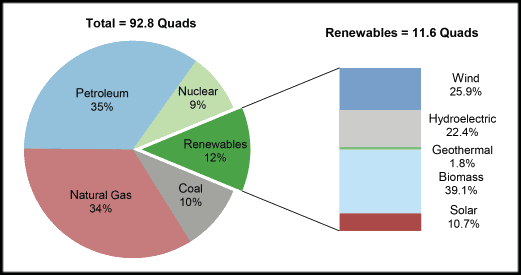Why were federal tax subsidies extended for wind and solar by Congress? Again. For the umpteenth time! We are against subsidies because they distort markets. Those politicians who support these market-distorting policies should at least be forced to answer the question: “How much is enough?” Taxpayers have been subsidizing wind and solar corporations for more than 40 years! These companies have gotten fat and happy on your money, and Congress keeps giving them more of it. This video is based on a Texas Public Policy Foundation report that explains why it’s long past time to stop wind and solar from stuffing their bank accounts with your tax dollars.
- To give you a sense of scale, to replace the energy from one average natural gas well, which sits on about four acres of land, would require 2,500 acres of wind turbines. That is a massive amount of land. You would have to cover this entire nation with wind turbines in an attempt to replace the electricity that we generate from coal, natural gas, and nuclear power, and even that would not get the job done. (CFACT)
This is from a recent BLOOMBERG article:
At his international climate summit in April, President Joe Biden vowed to cut U.S. greenhouse gas emissions in half by 2030. The goal will require sweeping changes in the power generation, transportation and manufacturing sectors. It will also require a lot of land.
Wind farms, solar installations and other forms of clean power tend to take up more space on a per-watt basis than their fossil-fuel-burning brethren. A 200-megawatt wind farm, for instance, might require spreading turbines over 13 square miles (36 square kilometres). A natural-gas power plant with that same generating capacity could fit onto a single city block.
Achieving Biden’s goal will require aggressively building more wind and solar farms, in many cases combined with giant batteries. To fulfill his vision of an emission-free grid by 2035, the U.S. needs to increase its carbon-free capacity by at least 150%. Expanding wind and solar by 10% annually until 2030 would require a chunk of land equal to the state of South Dakota, according to Princeton University estimates and an analysis by Bloomberg News. By 2050, when Biden wants the entire economy to be carbon free, the U.S. would need up to four additional South Dakotas to develop enough clean power to run all the electric vehicles, factories and more.
Earth Day 2021 is April 22nd. Therefore, eco-activist groups will be preaching the gospel of wind & solar power and the importance of biodiversity. What those trying to “save the planet” fail to understand (or more likely ignore) is that these two priorities are in direct conflict. Wind & solar require far more land than nuclear, natural gas and coal power. They are also far more destructive to regions of high biodiversity as well as large birds, bats and endangered species. As we celebrate Earth Day, let’s consider the significant environmental consequences of attempting to provide electricity through low density, unreliable sunshine and breezes.
Vice President Joe Biden aims to be the most progressive president on the issue of climate change. The man who spent most of 2020 hiding in the basement believes the future of energy is renewable energy like wind and solar. Biden should go back to the basement, watch Michael Moore’s “Planet of the Humans,” and rethink his advocacy for renewable energy. Wind and solar are not the answer, and the idea of converting our fossil fuel-based economy into renewables could be a devastating take-down to society.
Are we heading toward an all-renewable energy future, spearheaded by wind and solar? Or are those energy sources wholly inadequate for the task? Mark Mills, Senior Fellow at the Manhattan Institute and author of The Cloud Revolution, compares the energy dream to the energy reality.
Remember when Google joined the common sense era?
FLASHBACK
We came to the conclusion that even if Google and others had led the way toward a wholesale adoption of renewable energy, that switch would not have resulted in significant reductions of carbon dioxide emissions. Trying to combat climate change exclusively with today’s renewable energy technologies simply won’t work; we need a fundamentally different approach.
[…..]
“Even if one were to electrify all of transport, industry, heating and so on, so much renewable generation and balancing/storage equipment would be needed to power it that astronomical new requirements for steel, concrete, copper, glass, carbon fibre, neodymium, shipping and haulage etc etc would appear. All these things are made using mammoth amounts of energy: far from achieving massive energy savings, which most plans for a renewables future rely on implicitly, we would wind up needing far more energy, which would mean even more vast renewables farms – and even more materials and energy to make and maintain them and so on. The scale of the building would be like nothing ever attempted by the human race.”
Google Joins the Common Sense Crew On Renewable Energies ~ Finally! (RPT)
- What It Would Really Take to Reverse Climate Change: Today’s renewable energy technologies won’t save us. So what will? (SPETRUM)
- Shocker: Top Google Engineers Say Renewable Energy ‘Simply won’t work’ (WATTS UP WITH THAT)
- Polluting the Beauty and Cleanliness Of Our World With Renewable Energy (RPT)
- Wind and Solar More Harmful To Environment Than Helpful (RPT)
